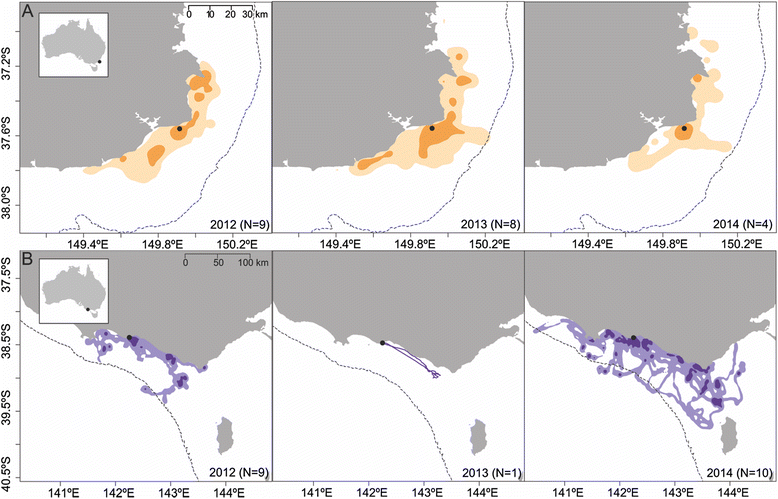Breeding short-tailed shearwaters buffer local environmental variability in south-eastern Australia by foraging in Antarctic waters
- PMID: 26236479
- PMCID: PMC4522076
- DOI: 10.1186/s40462-015-0044-7
Breeding short-tailed shearwaters buffer local environmental variability in south-eastern Australia by foraging in Antarctic waters
Abstract
Background: Establishing patterns of movements of free-ranging animals in marine ecosystems is crucial for a better understanding of their feeding ecology, life history traits and conservation. As central place foragers, the habitat use of nesting seabirds is heavily influenced by the resources available within their foraging range. We tested the prediction that during years with lower resource availability, short-tailed shearwaters (Puffinus tenuirostris) provisioning chicks should increase their foraging effort, by extending their foraging range and/or duration, both when foraging in neritic (short trips) and distant oceanic waters (long trips). Using both GPS and geolocation data-loggers, at-sea movements and habitat use were investigated over three breeding seasons (2012-14) at two colonies in southeastern Australia.
Results: Most individuals performed daily short foraging trips over the study period and inter-annual variations observed in foraging parameters where mainly due to few individuals from Griffith Island, performing 2-day trips in 2014. When performing long foraging trips, this study showed that individuals from both colonies exploited similar zones in the Southern Ocean. The results of this study suggest that individuals could increase their foraging range while exploiting distant feeding zones, which could indicate that short-tailed shearwaters forage in Antarctic waters not only to maintain their body condition but may also do so to buffer against local environmental stochasticity. Lower breeding performances were associated with longer foraging trips to distant oceanic waters in 2013 and 2014 indicating they could mediate reductions in food availability around the breeding colonies by extending their foraging range in the Southern Ocean.
Conclusions: This study highlights the importance of foraging flexibility as a fundamental aspect of life history in coastal/pelagic marine central place foragers living in highly variable environments and how these foraging strategies are use to buffer this variability.
Keywords: Foraging ecology; Geolocation; Movement; Procellariiforms; Reproductive performance; Southern Ocean.
Figures



References
-
- Ashmole NP. Seabird ecology and the marine environment. In: Farner DS, King JR, editors. Avian biology. New York, N.Y., U.S.A.: Academic Press; 1971. pp. 223–86.
-
- Hansen J, Martos P, Madirolas A. Relationship between spatial distribution of the Patagonian stock of Argentine anchovy, Engraulis anchoita, and sea temperatures during late spring to early summer. Fish Oceanogr. 2001;10:193–206.
-
- Weimerskirch H. Are seabirds foraging for unpredictable resources? Deep-Sea Res II Top Stud Oceanogr. 2007;54:211–23.
-
- Frederiksen M, Harris MP, Daunt F, Rothery P, Wanless S. Scale-dependent climate signals drive breeding phenology of three seabird species. Glob Chang Biol. 2004;10:1214–21.
LinkOut - more resources
Full Text Sources
Other Literature Sources
Research Materials

